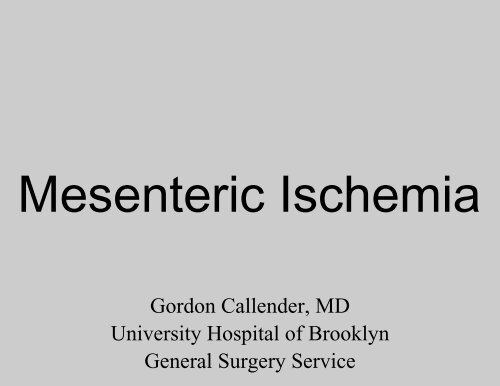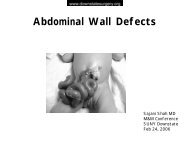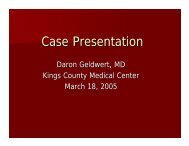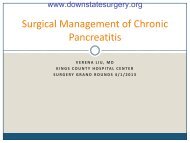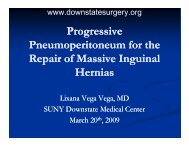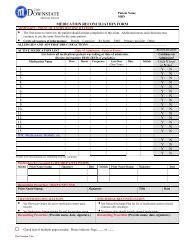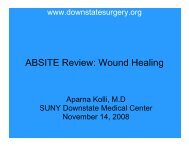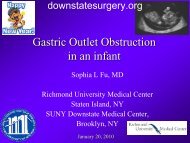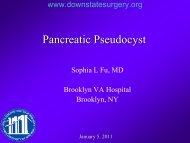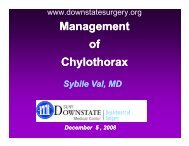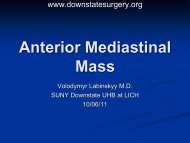Mesenteric Ischemia
Mesenteric Ischemia
Mesenteric Ischemia
You also want an ePaper? Increase the reach of your titles
YUMPU automatically turns print PDFs into web optimized ePapers that Google loves.
<strong>Mesenteric</strong> <strong>Ischemia</strong><br />
Gordon Callender, MD<br />
University Hospital of Brooklyn<br />
General Surgery Service
1.Definition<br />
2.History<br />
Topics<br />
3.Pathophysiology<br />
4.Etiology & Subtypes<br />
5.Clinical Presentation<br />
6.Diagnosis<br />
1.Laboratory & Radiographic Evidence?<br />
2.Role of Bedside Laparoscopy?<br />
7.Management<br />
3.Role of Second Look Laparotomy?
Definition<br />
• Bowel ischemia is a complex disease caused by a drastic<br />
reduction in blood supply to the mesentery, that can be due to<br />
lack of arterial blood flow, venous occlusion or low cardiac<br />
output.<br />
• Overall incidence is ~1% of all patients hospitalized for an<br />
acute abdomen.
History<br />
•Described by Beniviene in 1509.<br />
•Cokkinis stated in 1921 that “occlusion of the mesenteric<br />
vessels is regarded as one of those conditions of which the<br />
diagnosis is impossible, the prognosis hopeless, and the<br />
treatment almost useless”.<br />
•Overall mortality has not improved much despite more<br />
aggressive diagnostic and therapeutic measures.
Pathophysiology<br />
•Acute ischemia can cause:<br />
• diffuse abdominal pain, and often fail to note abdominal distention.<br />
• vasospasm, which causes gut emptying or profuse vomiting and<br />
diarrhea.<br />
• mucosal sloughing occurs and concomitant GI bleeding.<br />
•Normal patients exhibit postprandial hyperemia on<br />
angiography. Some patients with mesenteric ischemia lose<br />
this hyperemia, but returns following restoration of blood flow.
Etiology / Subtypes<br />
Non-Occlu<br />
Mesenter<br />
Ischemi<br />
Non<br />
Non-Occlu<br />
Occlu<br />
Mesente<br />
Mesenter<br />
Ischemi<br />
Ischemi<br />
usive<br />
ease<br />
usive<br />
usive<br />
ease<br />
ease<br />
Non-Occlu<br />
Disease<br />
Non<br />
Non-Occlu<br />
Occlu<br />
Diseas<br />
Disease<br />
Venous<br />
Thrombosis<br />
Venous<br />
Venous<br />
Thrombosis<br />
Thrombosis<br />
Chronic <strong>Mesenteric</strong><br />
<strong>Ischemia</strong><br />
Chronic <strong>Mesenteric</strong><br />
Chronic <strong>Mesenteric</strong><br />
<strong>Ischemia</strong><br />
<strong>Ischemia</strong><br />
Acute<br />
Chronic<br />
rial<br />
olism<br />
erial<br />
rial<br />
olism<br />
olism<br />
Arterial<br />
Thrombosis<br />
Arterial<br />
Arterial<br />
Thrombosis<br />
Thrombosis<br />
Extravascular<br />
Causes<br />
Extravascular<br />
Extravascular<br />
Causes<br />
Causes
Causes of <strong>Mesenteric</strong><br />
<strong>Ischemia</strong><br />
• Arterial Occlusion (~50% of cases)<br />
• Emboli to SMA due to atrial fibrillation or mural thrombi due to cardiac<br />
hypokinesia<br />
• Thrombotic occlusion due to pre-existing atherosclerotic vessel<br />
disease or acute obstruction with underlying chronic mesenteric<br />
ischemia<br />
• Cardiac valvular lesions/vegetations<br />
• Atheroemboli<br />
• Dissecting aortic aneurysm<br />
• Fibromuscular dyplasia<br />
• Trauma<br />
• Endotoxin induced shock
Causes of <strong>Mesenteric</strong><br />
<strong>Ischemia</strong><br />
•Non-occlusive mesenteric ischemia (~20-30% of cases)<br />
•Systemic hypotension<br />
•Cardiac failure<br />
•Septic shock<br />
•<strong>Mesenteric</strong> vasoconstriction (owing to sympathetic<br />
response)
Causes of <strong>Mesenteric</strong><br />
<strong>Ischemia</strong><br />
•Venous occlusion (~5-15% of cases)<br />
• Primary vein thrombosis<br />
• Deficiency of protein C and S, antithrombin III, factor V Leiden<br />
• Antiphospholipid syndrome<br />
• Paroxysmal nocturnal hemaglobinuria<br />
• Secondary vein thrombosis<br />
• Paraneoplastic<br />
• Pancreatitis<br />
• Inflammatory bowel disease<br />
• Cirrhosis and portal hypertension<br />
• Previous sclerotherapy of varices<br />
• Splenomegaly/Splenectomy<br />
• Trauma<br />
• Oral / Transdermal contraceptives
Causes of <strong>Mesenteric</strong><br />
<strong>Ischemia</strong><br />
•Extravascular sources ischemia (~20-30% of cases)<br />
•Incarcerated hernia<br />
•Volvulus<br />
•Intussusception<br />
•Adhesive bands
Clinical Presentation<br />
•A difficult diagnosis to make, as most patients present with nonspecific<br />
symptoms.<br />
•Classically, pain is disproportionately exaggerated relative to<br />
unremarkable physical findings and may persist beyond two to<br />
three hours.<br />
•Fever, diarrhea, nausea and anorexia are commonly reported<br />
•Melena or hematochezia seen in 15%; guaiac + in >50%.
Diagnosis<br />
•High index of suspicion is required to limit or prevent patients<br />
from developing generalized peritonitis which may represent<br />
intestinal infarction.<br />
•Especially should be considered in patients with a history of<br />
atrial fibrillation in patients older than 60 years of age, or<br />
patients with postprandial abdominal pain and weight loss.<br />
•Survival ~ 50% when diagnosed with 24 hours of onset of<br />
symptoms, but decreases to less than 30% when delayed.
Oldenburg WA et al. Arch Intern Med. 2004;164:1054-1062.<br />
Laboratory<br />
•May have a profound leukocytosis of 25-40k.<br />
•May have a metabolic acidosis.<br />
•Often demonstrate hemoconcentration on the CBC.<br />
•May also see a widened anion gap and lactic acid levels.<br />
Amylase, AST, LDH, CPK may also be elevated but is fairly<br />
non-specific.
Radiology<br />
•Plain films: Usually non-specific in early stages. Later they<br />
may reveal bowel distension, air fluid levels and sometimes<br />
pneumatosis along with gas in the portal vein.
Radiology<br />
•Ultrasound:<br />
•Using duplex scanning, U/S offers a noninvasive, and<br />
inexpensive guide in assessing portomesenteric flow<br />
especially in cases of mesenteric venous thrombosis.<br />
•Limitations include presence of bowel gas which may<br />
obscure, operator skill dependent.<br />
•U/S can also be used to identify other differential causes<br />
including cholecystitis, or pancreatitis.
Radiology<br />
•CT scans:<br />
•Multi-detector row CT allows for 92% specificity and 64%<br />
sensitivity in determining the presence of mesenteric<br />
ischemia.<br />
•Offers the ability to perform 3D reconstructions.
Radiology
Radiology
Radiology<br />
•MRI/MRA: Can be used to identify<br />
stenotic lesions, especially in patients<br />
with chronic ischemia.
Radiology<br />
•Angiogram:<br />
•“Gold standard” for diagnosis<br />
•Offers not only a diagnostic but therapeutic option (ex.<br />
thrombolytics or use of papaverine as a vasodilator)<br />
•Disadvantage includes invasive measure, and cost.
Treatment<br />
•Mainstay of treatment is surgical exploration, especially if<br />
patients exhibit peritoneal signs.<br />
•Goal of surgery includes:<br />
1.Determining any vascular compromise amenable to<br />
embolectomy, or if a vascular reconstruction using a<br />
saphenous vein graft for a aortomesenteric bypass.<br />
2.Resecting compromised bowel.<br />
3.Consider a second look laparotomy.
Role of Second Look<br />
Laparotomy<br />
•Defined as a planned reoperation<br />
•First devised in 1965.<br />
•Resect all necrotic bowel at the first operation and take the<br />
patient back to the OR within 24 hours despite the clinical<br />
course of the patient.<br />
•One study examined any benefit in a second look laparotomy<br />
and failed to demonstrate any benefit.
Laparoscopy following<br />
recent laparotomy?<br />
•Some authors have suggested a possible role for laparoscopy<br />
following a recent laparotomy.<br />
•Rosin and performed a case report (n=14) for various<br />
indications following a recent laparotomy (one was for an<br />
abdominal abscess following a case of mesenteric ischemia),<br />
others included SBO following laparotomy for trauma or other<br />
indications.<br />
•Used a lateral approach away from the incision via a Hasson<br />
canula.<br />
•Found laparoscopy to be a safe adjunct to treat recent<br />
laparotomies.
Diagnostic Bedside<br />
Laparoscopy<br />
•May be useful in septic patients in the ICU to r/o abdominal<br />
causes of sepsis (ex. abscess, mesenteric ischemia).<br />
•Ideal for patients too unstable for transport for diagnostic or<br />
therapeutic measures (CT scan or angiography suite)<br />
•Gagné and colleagues examined n=19 (1 patient had 2<br />
procedures, for a total n=20).<br />
• Procedure time: 9-68 min (mean: 21 min)<br />
• Three had extensive mesenteric ischemia (no laparotomy)<br />
• One had questionable bowel viability, and a subsequent formal negative lap<br />
• One patient had a necrotic GB and another had a small ischemic segment of bowel and bot<br />
were treated open.<br />
• The remaining 14 examinations were normal, and helped to avoid a nontherapeutic<br />
laparotomy in 19 of 20 patients.
val varies depending on<br />
of ischemia.<br />
Statistics<br />
Type<br />
Mortality<br />
(Surgical Rx)<br />
Morta<br />
(Non<br />
Surgica<br />
AE 54% 96%<br />
all better prognosis for<br />
nts with arterial emboli (AE)<br />
enous thrombosis (VT) vs.<br />
al thrombosis (AT) and<br />
I.<br />
tanalysis of 45 studies and<br />
er 3600 patients.<br />
AT 77% 99%<br />
VT 32% 87%<br />
NOMI 56% 96%
Short Bowel Syndrome<br />
•Global malabsorption syndrome due to lack of absorptive<br />
capacity or due to disturbed GI regulation as a result of<br />
extensive small bowel resection.<br />
•May occur following resection of > 50% of total length<br />
•Obligatory after resecting 70% of small bowel length or if <<br />
100 cm of small bowel remains.<br />
•Overall incidence of severe cases are estimated to be 1-2<br />
cases per 100,000
Phases of Short Bowel<br />
Syndrome<br />
•Acute Phase:<br />
• Starts after resection<br />
• Lasts less than 4 weeks.<br />
•Adaptation Phase:<br />
• Lasts 1-2 years<br />
• Maximal stimulation of intestinal adaptation is achieved by gradually<br />
increasing intestinal nutrient exposure via increasing mucosal surface<br />
area, decreasing intestinal motility.<br />
• Important neurohormonal mediators include glucagon-like peptide 1 and<br />
2 (GLP-1 and 2), peptide YY (PYY) and neurotensin.
Phases of Short Bowel<br />
Syndrome<br />
•Maintenance Phase:<br />
•Permanent dietetic treatments must be individualized<br />
•Patients with Crohn’s in particular should receive effective<br />
therapy to limit or prevent acute exacerbation.
SBS Induced<br />
Malnutrition<br />
• Fat soluble nutrients and vitamins (A, D, E, K) are poorly absorbed.<br />
• Water soluble vitamin deficiencies (ex. B1, B2, B6 and C) are rare.<br />
• Hyperoxaluria is commonly seen and causes nephrolithiasis of oxalate stones in<br />
up to 60% of patients. Similarly due to the loss of terminal ileum, patients develo<br />
a vitamin B12 deficiency.<br />
• Calcium, magnesium, iron and folic acid deficiencies are commonly seen in<br />
extensive proximal small bowel resections.
Summary<br />
•The diagnosis of mesenteric ischemia requires a high index of<br />
suspicion.<br />
•Requires prompt treatment to prevent bowel infarction.<br />
•Bedside laparoscopy is a viable option to evaluate the small<br />
bowel in unstable patients.<br />
•Consider a second look laparotomy if bowel viability is in<br />
question.


